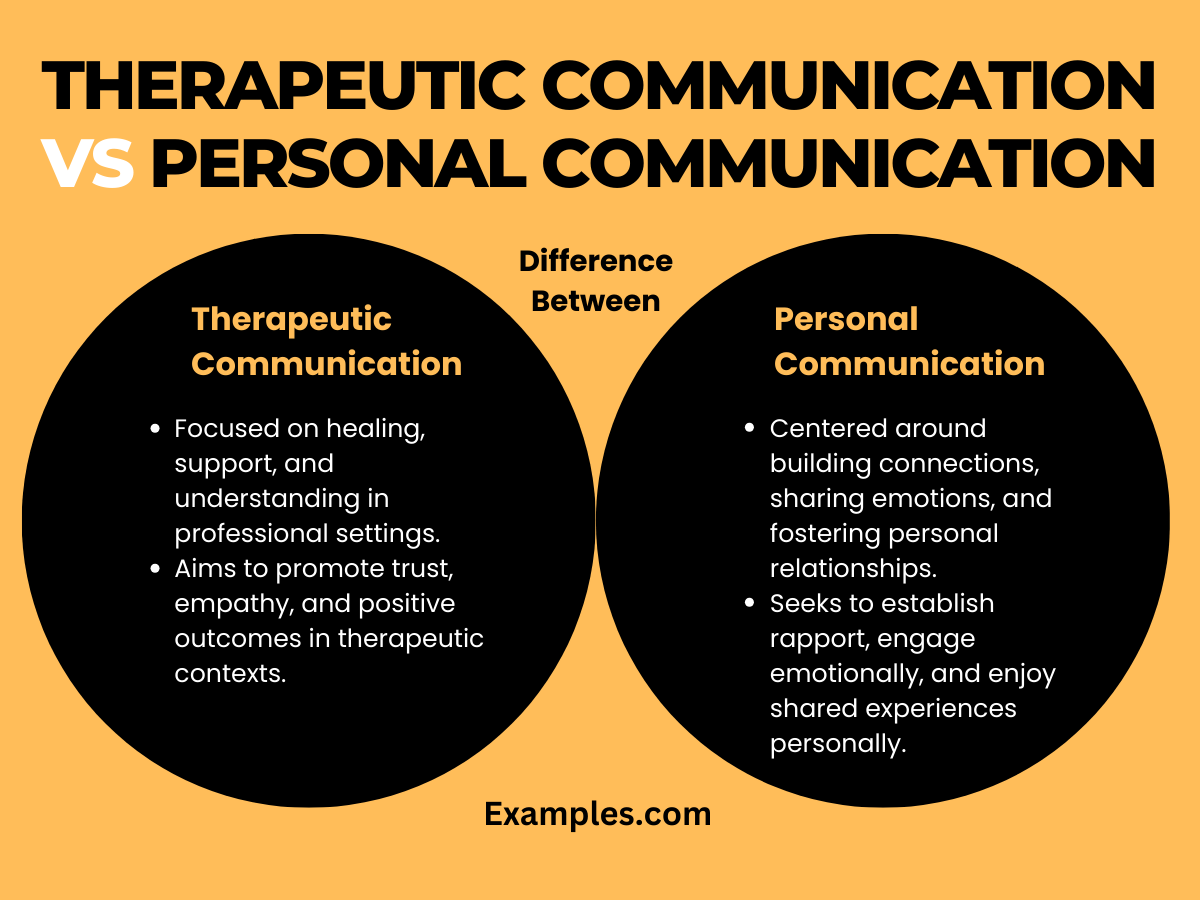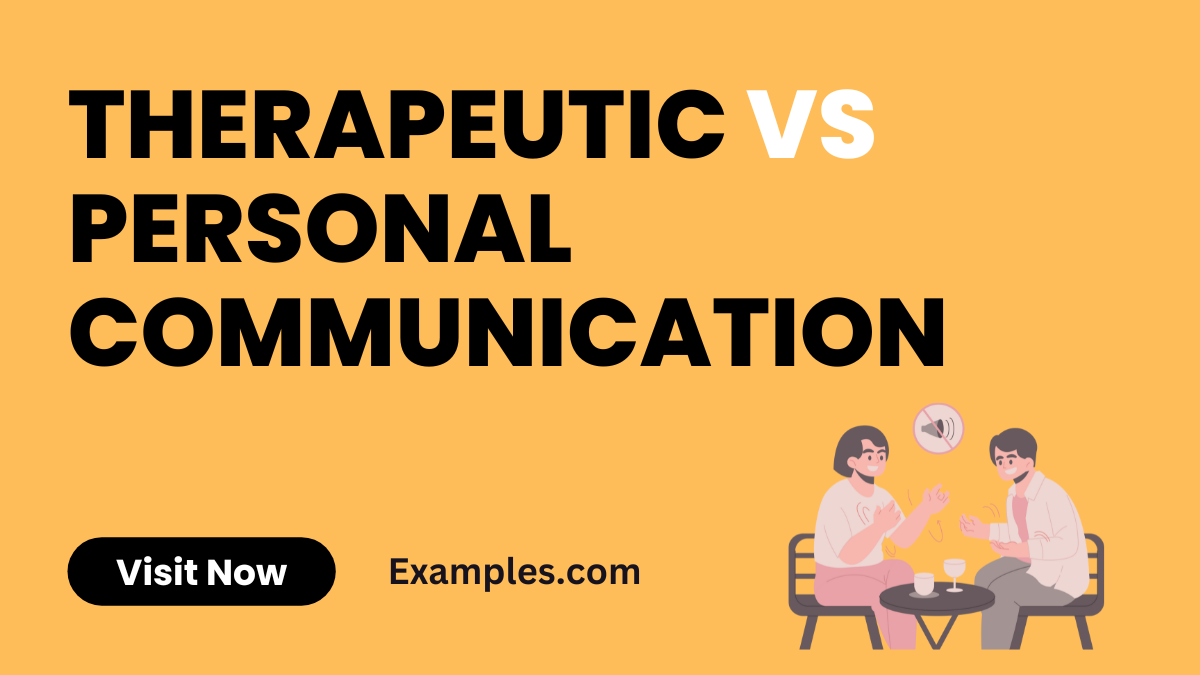Therapeutic Communication vs Personal Communication – 9+ Examples
Embark on a journey through the intricacies of Therapeutic Communication vs Personal Communication. This guide explores the nuances, offering examples and expert tips to navigate both realms seamlessly. Uncover effective communication strategies tailored for therapeutic settings and personal interactions. Dive into real-world communication examples that transcend professional and private spheres, providing valuable insights to enhance your interpersonal skills. Explore the power of words in diverse contexts with this illuminating guide on Therapeutic and Personal Communication Examples.
What is the difference between Therapeutic Communication and Personal Communication?

In the realm of interpersonal dynamics, understanding the distinctions between therapeutic and personal communication is essential. This comprehensive guide dissects the nuances, providing clarity on the contrasting features of these communication styles.
| Aspect | Therapeutic Communication | Personal Communication |
|---|---|---|
| Purpose | Focuses on healing, support, and understanding in professional settings. | Centered around building connections, sharing emotions, and fostering personal relationships. |
| Goal | Aims to promote trust, empathy, and positive outcomes in therapeutic contexts. | Seeks to establish rapport, engage emotionally, and enjoy shared experiences personally. |
| Setting | Primarily in healthcare, counseling, or supportive environments. | Encompasses a broad range of settings, from casual gatherings to personal relationships. |
| Verbal Expression | Emphasizes clarity, supportive language, and active listening skills. | Allows for varied expression, from formal discussions to informal banter as per personal connections. |
| Non-Verbal Cues | Open body language, focused eye contact, and empathetic gestures. | Diverse and context-dependent, encompassing a wide range of expressions in personal interactions. |
| Empathy and Validation | Prioritizes understanding and validating emotions and feelings. | May include empathy but may not consistently focus on validation in every personal interaction. |
| Active Listening | Actively engages in listening, paraphrasing, and clarifying information. | Listening styles vary, with a focus on understanding in personal connections. |
| Participant Roles | May involve a professional and a patient or client. | Typically involves peers, friends, or family members as equal participants. |
| Feedback and Reflection | Provides constructive feedback, fostering personal growth. | Feedback styles may vary, ranging from constructive to casual in personal connections. |
| Cultural Sensitivity | Demonstrates cultural competence and sensitivity in diverse contexts. | Cultural sensitivity may vary based on individuals involved in personal interactions. |
Navigate the intricacies of therapeutic and personal communication with this guide, offering insights to adapt your communication style based on context and desired outcomes. Understanding these distinctions enhances your ability to navigate diverse social scenarios effectively.
10 Therapeutic Communication Examples
Explore examples that illustrate the delicate balance between therapeutic and personal communication. Each example is crafted to enhance your understanding and application of these distinct styles. Elevate your communication skills in therapeutic settings and personal interactions alike, fostering meaningful connections.
- Active Listening in Therapy:
Example: Boldly engage, “I hear your concerns; let’s work through them together.” - Casual Greetings with Friends:
Example: Start conversations warmly, “Hey, how’s it going? Long time no see!” - Empathy in Counseling:
Example: Demonstrate understanding, “I can sense this is challenging for you; I’m here to support.” - Sharing Personal News with Family:
Example: Inform others, “Exciting news—I got the job I applied for!” - Open-Ended Questions in Therapy:
Example: Encourage reflection, “Can you share more about how you’ve been feeling lately?” - Casual Information Sharing:
Example: Convey facts casually, “The party is at 7 PM at Sarah’s place.” - Reflective Techniques in Counseling:
Example: Use reflection, “It seems like you’re experiencing a range of emotions; tell me more.” - Sharing Weekend Plans Socially:
Example: Engage socially, “Any exciting plans for the weekend?” - Validation in Therapeutic Setting:
Example: Acknowledge emotions, “Your feelings are valid; let’s navigate this together.” - Expressing Opinions Casually:
Example: Share viewpoints, “I think this movie is fantastic; what are your thoughts?”
These examples provide a glimpse into the subtle yet crucial differences between therapeutic and personal communication, empowering you to navigate diverse interactions successfully.
10 Personal Communication Examples
Discover personal communication examples designed to enrich your everyday interactions. Crafted for diverse settings, these examples elevate your ability to connect, share, and engage authentically.
- Casual Greetings with Friends:
Example: Start conversations warmly, saying boldly, “Hey, how’s it going? Long time no see!” - Sharing Weekend Plans Socially:
Example: Engage socially, “Any exciting plans for the weekend?” - Expressing Opinions in a Group:
Example: Share viewpoints, “I think this movie is fantastic; what are your thoughts?” - Celebrating Achievements:
Example: Share good news, “Exciting news—I got the job I applied for!” - Providing Comfort in Tough Times:
Example: Offer support, “I’m here for you; we’ll get through this together.” - Sharing Personal Interests:
Example: Discuss hobbies, “I recently started painting; it’s a great stress reliever.” - Casual Information Sharing:
Example: Convey facts casually, “The party is at 7 PM at Sarah’s place.” - Reflecting on Personal Experiences:
Example: Share experiences, “I had a memorable trip to the mountains last summer.” - Discussing Future Plans:
Example: Plan ahead, “Let’s explore new places together next year.” - Expressing Gratitude:
Example: Show appreciation, “Thank you for always being there; your support means a lot.”
These personal communication examples empower you to build stronger connections, fostering authenticity and camaraderie in your personal relationships.
What is the comparison between Therapeutic Communication and Personal Communication?
Here is a comparison between Therapeutic Communication and Personal Communication in a tabular format:
| Aspect | Therapeutic Communication | Personal Communication |
|---|---|---|
| Purpose | Facilitates understanding, support, and positive outcomes, especially in healthcare or counseling. | Focused on building personal relationships, sharing experiences, and socializing. |
| Setting | Primarily in professional, healthcare, or counseling environments. | Occurs in a variety of settings, usually informal and personal. |
| Focus | Patient-centered, emphasizing empathy, active listening, and validation. | Centered on personal interests, experiences, and mutual enjoyment. |
| Verbal Style | Clear, concise, and supportive language, tailored to patient’s needs. | Casual, informal, and varies based on personal relationships and context. |
| Non-Verbal Cues | Open body language, focused eye contact, and empathetic gestures. | Diverse, dependent on personal comfort and relationship dynamics. |
| Empathy and Validation | Prioritizes understanding and validating emotions and feelings in a professional context. | May include empathy, but focuses more on mutual understanding and personal connection. |
| Active Listening | Actively engages in listening, paraphrasing, and clarifying information for therapeutic purposes. | Listening styles vary, generally more relaxed and less structured than therapeutic listening. |
| Relationship Building | Strengthens therapeutic alliances for positive outcomes in a professional setting. | Establishes and maintains personal connections for friendship, family ties, or romance. |
| Use of Silence | Utilizes purposeful silence for reflection or understanding in a therapeutic context. | Silence in personal communication is context-dependent and serves various social purposes. |
| Feedback and Reflection | Provides constructive feedback, fostering personal growth in a therapeutic setting. | Feedback styles in personal communication may vary, often more casual and less structured. |
| Cultural Sensitivity | Demonstrates cultural competence and sensitivity in diverse professional contexts. | Cultural sensitivity varies based on personal awareness and the nature of the personal relationship. |
This comparison highlights the distinct approaches and purposes of therapeutic and personal communication, emphasizing the unique nuances of each style.
What is the Relationship between Therapeutic Communication and Personal Communication?
Certainly! Here’s a new perspective on the relationship between therapeutic and personal communication in table format:
| Aspect | Therapeutic Communication | Personal Communication |
|---|---|---|
| Synergy | Strives for a harmonious blend of empathy, active listening, and professional rapport. | Aims for a seamless integration of personal warmth, shared experiences, and genuine connections. |
| Flexibility | Adapts communication strategies to suit the unique needs of individuals seeking support. | Embraces flexibility to cater to the diverse dynamics of personal relationships and social contexts. |
| Reciprocity | Encourages a reciprocal exchange where both parties contribute to the conversation’s depth. | Thrives on a mutual give-and-take, where shared interests and open dialogue strengthen connections. |
| Objective | Focuses on achieving therapeutic goals, promoting well-being, and addressing specific concerns. | Driven by the objective of fostering meaningful connections, enjoyment, and shared moments in personal relationships. |
| Depth of Connection | Establishes deep, trusting connections often integral to the therapeutic process. | Cultivates connections that vary in depth, adapting to the closeness desired in personal relationships. |
| Professionalism | Emphasizes a professional demeanor while maintaining empathy and compassion. | Balances professionalism with personal authenticity, allowing for a more relaxed and intimate atmosphere. |
| Boundaries | Navigates within established professional boundaries for ethical and effective communication. | Respects personal boundaries, adapting communication styles to ensure comfort and mutual respect. |
| Outcome Orientation | Geared towards achieving specific therapeutic outcomes and positive mental health results. | Oriented towards cultivating positive experiences, joy, and lasting memories in personal connections. |
| Contextual Sensitivity | Demonstrates heightened awareness of the therapeutic context, adjusting communication accordingly. | Adapts to varying social contexts, showcasing sensitivity to the dynamics of personal relationships. |
| Communication Styles | Incorporates structured and focused communication techniques tailored to individual needs. | Leverages diverse communication styles, allowing for a spectrum from formal to informal based on relational dynamics. |
This perspective highlights the nuanced relationship between therapeutic and personal communication, showcasing their unique characteristics and the distinct qualities they bring to interpersonal interactions.
In conclusion, differentiating between Therapeutic Communication and Personal Communication is vital for navigating diverse interactions. This guide provides insights into their nuances, offering real-world examples and strategies. Whether fostering connections in healthcare or personal relationships, understanding and applying these communication styles enhance the quality of interactions, promoting empathy, understanding, and positive outcomes.



